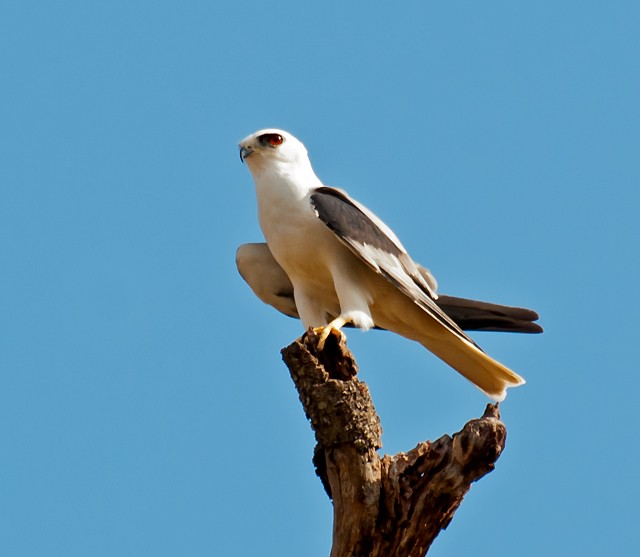White-tailed Kite
A species of Black-shouldered Kites Scientific name : Elanus leucurus Genus : Black-shouldered Kites
White-tailed Kite, A species of Black-shouldered Kites
Botanical name: Elanus leucurus
Genus: Black-shouldered Kites
Content
Description General Info
 Photo By Dario Sanches , used under CC-BY-SA-2.0 /Cropped and compressed from original
Photo By Dario Sanches , used under CC-BY-SA-2.0 /Cropped and compressed from original Description
The coloration of the white-tailed kite is gull-like, but its shape and flight is falcon-like, with a rounded tail. Mainly white underneath, it has black wingtips and shoulders. A mid-sized kite, it measures 35–43 cm (14–17 in) in length, spans 88–102 cm (35–40 in) across the wings and weighs 250–380 g (8.8–13.4 oz). Both the wings and tail are relatively elongated, and the tarsus measures around 3.6 cm (1.4 in). 
Size
38-43 cm (15-17 in)
Colors
Black
Gray
White
Life Expectancy
6 years
Nest Placement
Tree
Clutch Size
4 eggs
Incubation Period
1 brood
Number of Broods
30 - 32 days
Nestling Period
35 - 38 days
Feeding Habits
White-tailed Kite predominantly consumes small mammals, occasionally supplementing its diet with birds, lizards, and insects. White-tailed Kite practices a distinctive hunting technique involving hovering into the wind at heights up to 80 feet to spot and then dive onto its prey with feet extended and wings aloft.
Habitat
White-tailed Kite resides in open areas like savannas, marshes, and grasslands, suitable for foraging and nesting. They are adaptable to varying altitudes in lowland regions, preferring spaces with trees for perching. Habitats range from rural to suburban, avoiding dense forests and overgrazed lands. Their adaptability supports their resilience in diverse environments.
Nest Behavior
Both white-tailed Kite parents may partake in selecting a site and constructing the nest. Egg-laying timing and patterns vary, with attentive parental care provided during the incubation and rearing of their young.
Nest Characteristics
White-tailed Kite nests are commonly found in the top third of isolated or forest-edge trees, reaching heights of 10-160 feet. These shallow bowls, roughly 21 inches wide, comprise small twigs and feature a soft lining of grass, hay, or leaves. The inner cup spans about 7 inches across and 4 inches deep.
Dite type
Carnivorous
General Info
Feeding Habits
Bird food type
Behavior
White-tailed Kite exhibit a fascinating aerial hunting technique where they hover at elevations around 80 feet, meticulously observing before swooping down swiftly onto their prey. This characteristic hovering is aptly termed 'kiting', as they adeptly maintain a stationary position against the wind. White-tailed Kite are not particularly aggressive in maintaining their territories compared to other raptors but will defend against intruders with a dramatic aerial display that sometimes includes talon-locking and tumbling. Their social structure during the breeding season is noteworthy, as couples partake in a courtship involving prey exchange midair, displaying commitment and cooperation. Despite forming pairs in the breeding season, fidelity across seasons varies.
Distribution Area
The white-tailed kite was rendered almost extinct in California in the 1930s and 1940s due to shooting and egg-collecting, but they are now common again. Their distribution is patchy, however. They can be found in the Central Valley and southern coastal areas, open land around Goleta including the Ellwood Mesa Open Space, marshes in Humboldt County, and also around the San Francisco Bay. Elsewhere in California, they are still rare or absent. They are also found from southern Texas and eastern Mexico to the Baja California Peninsula and through Central and South America to central Argentina and Chile. Globally, they are not considered threatened species by the IUCN. On rare occasions the bird can be found far outside its usual range. At different times, two had been sighted in New England as of 2010. 
Species Status
Not globally threatened.